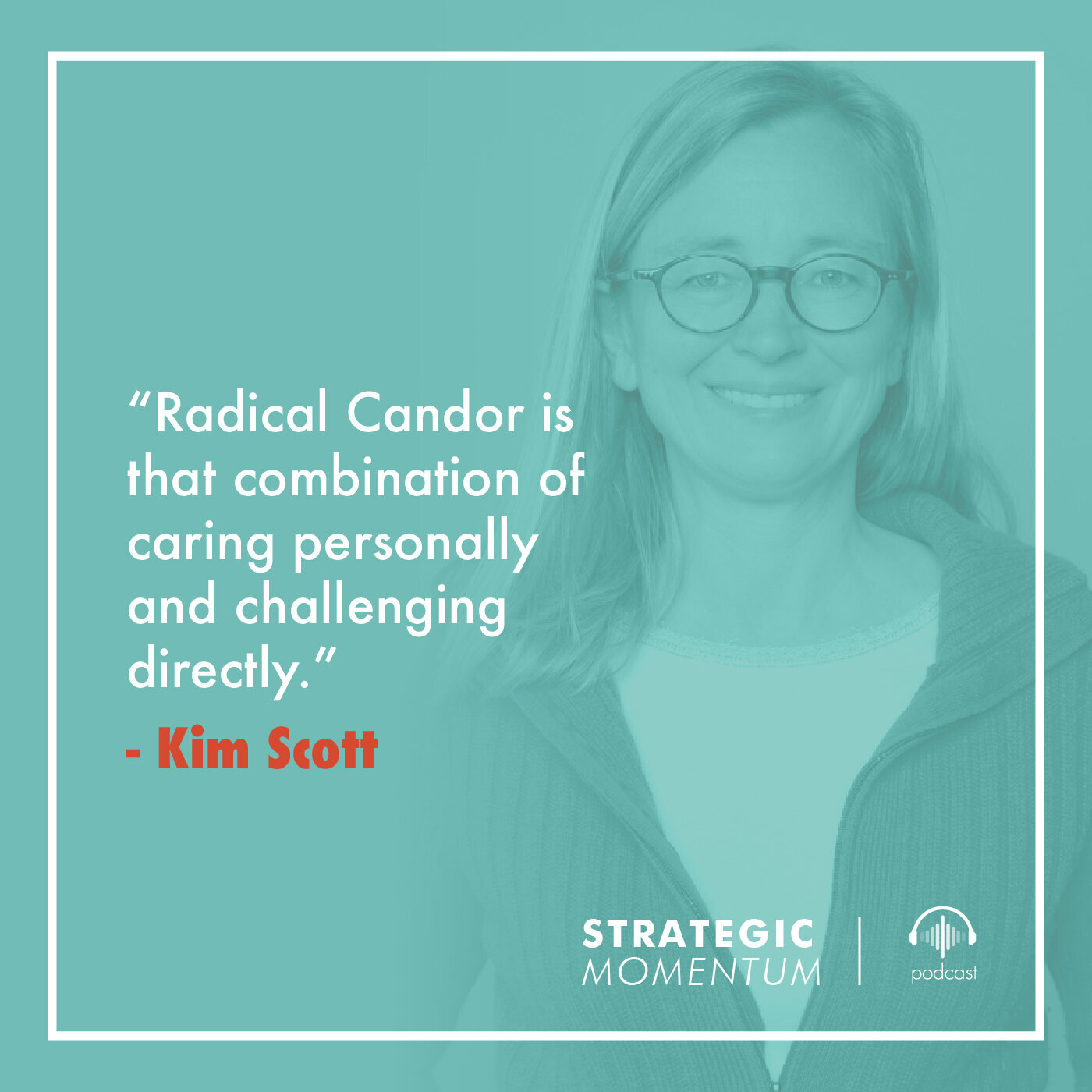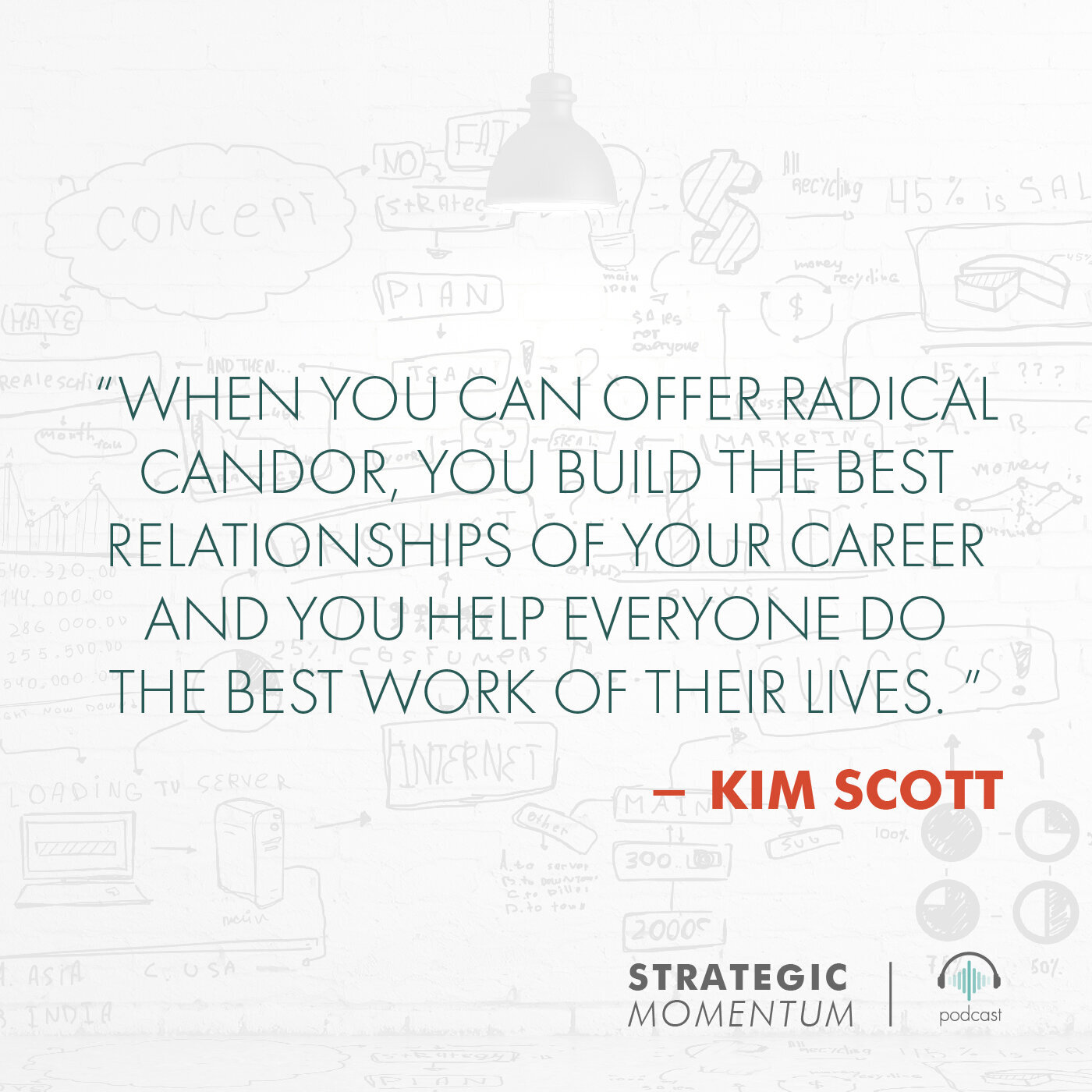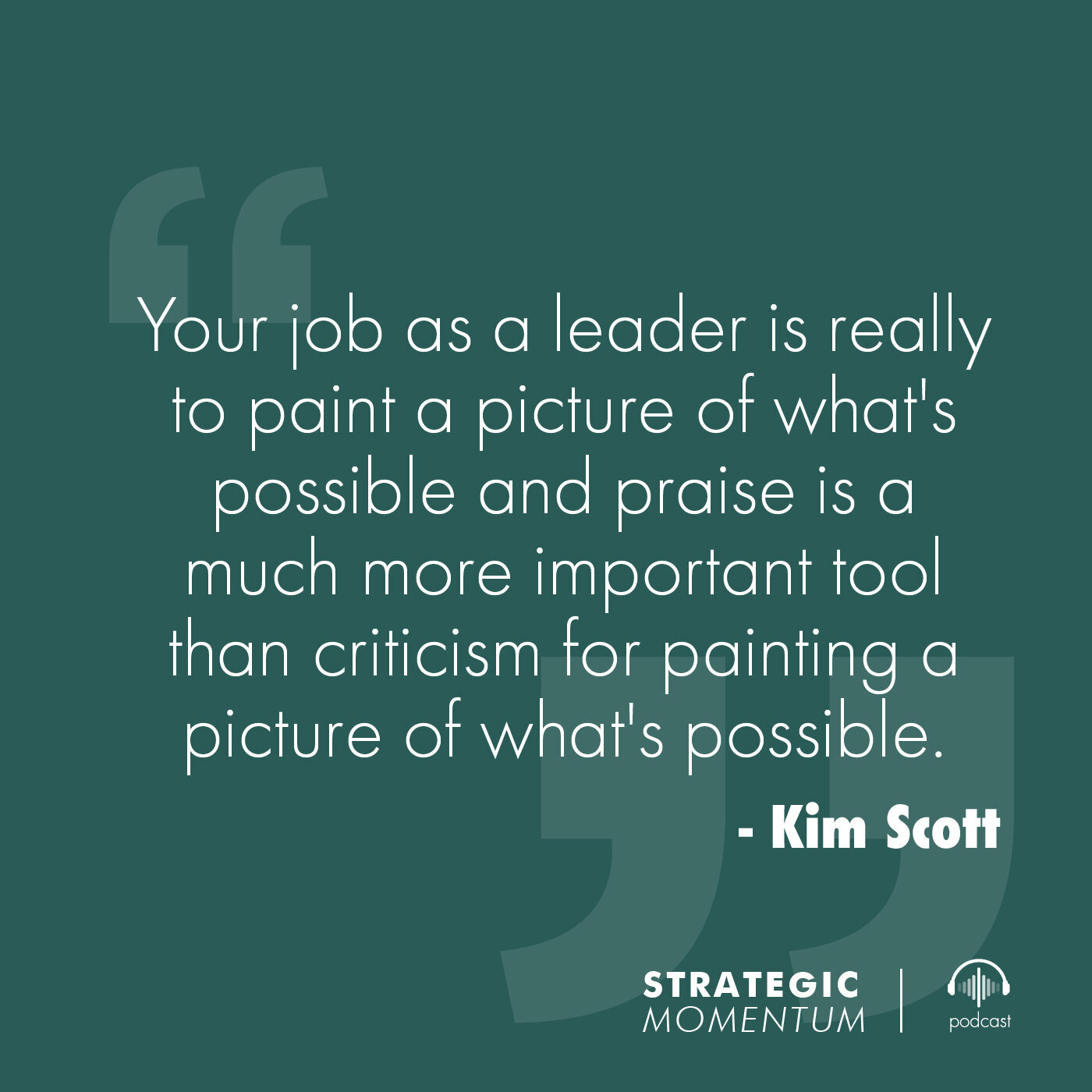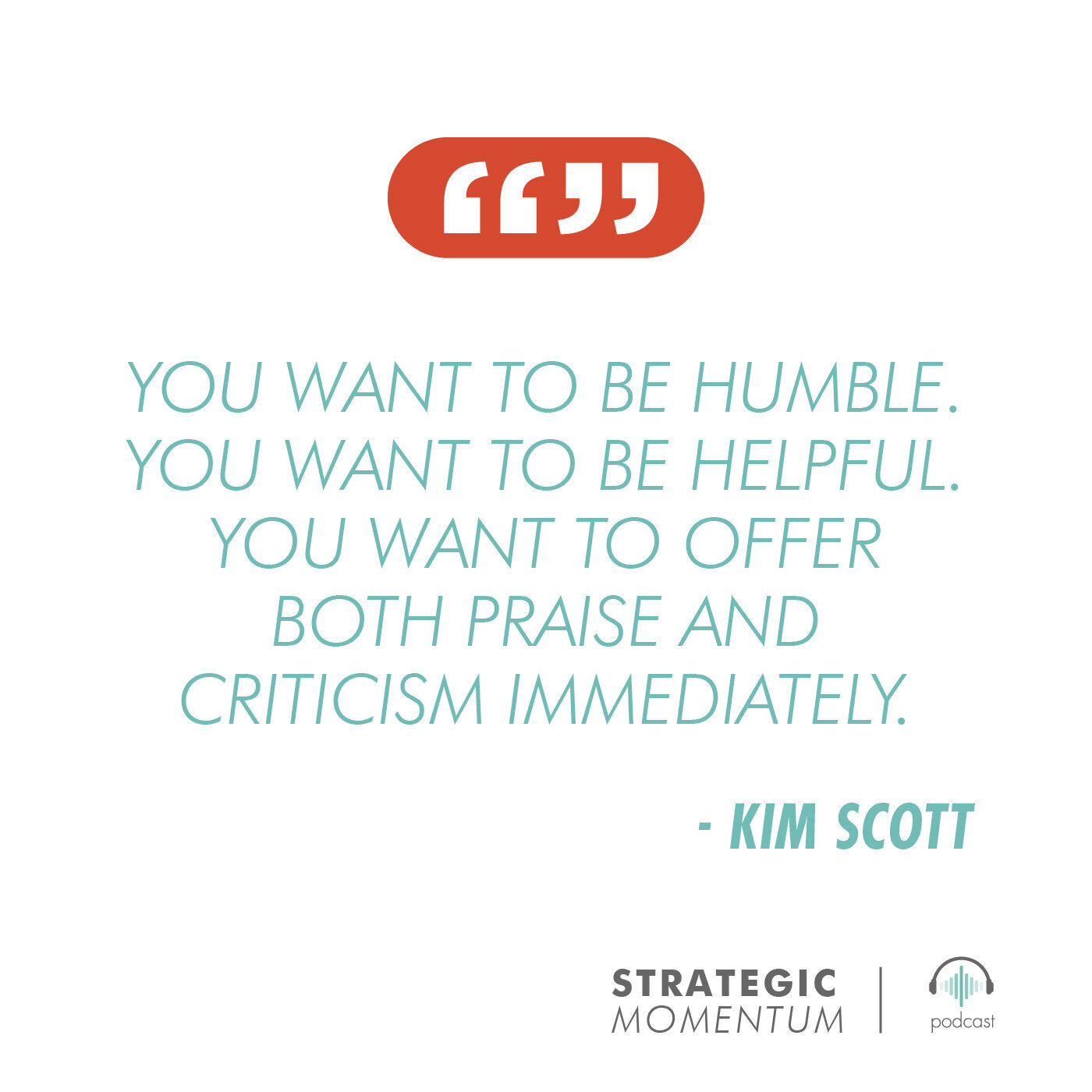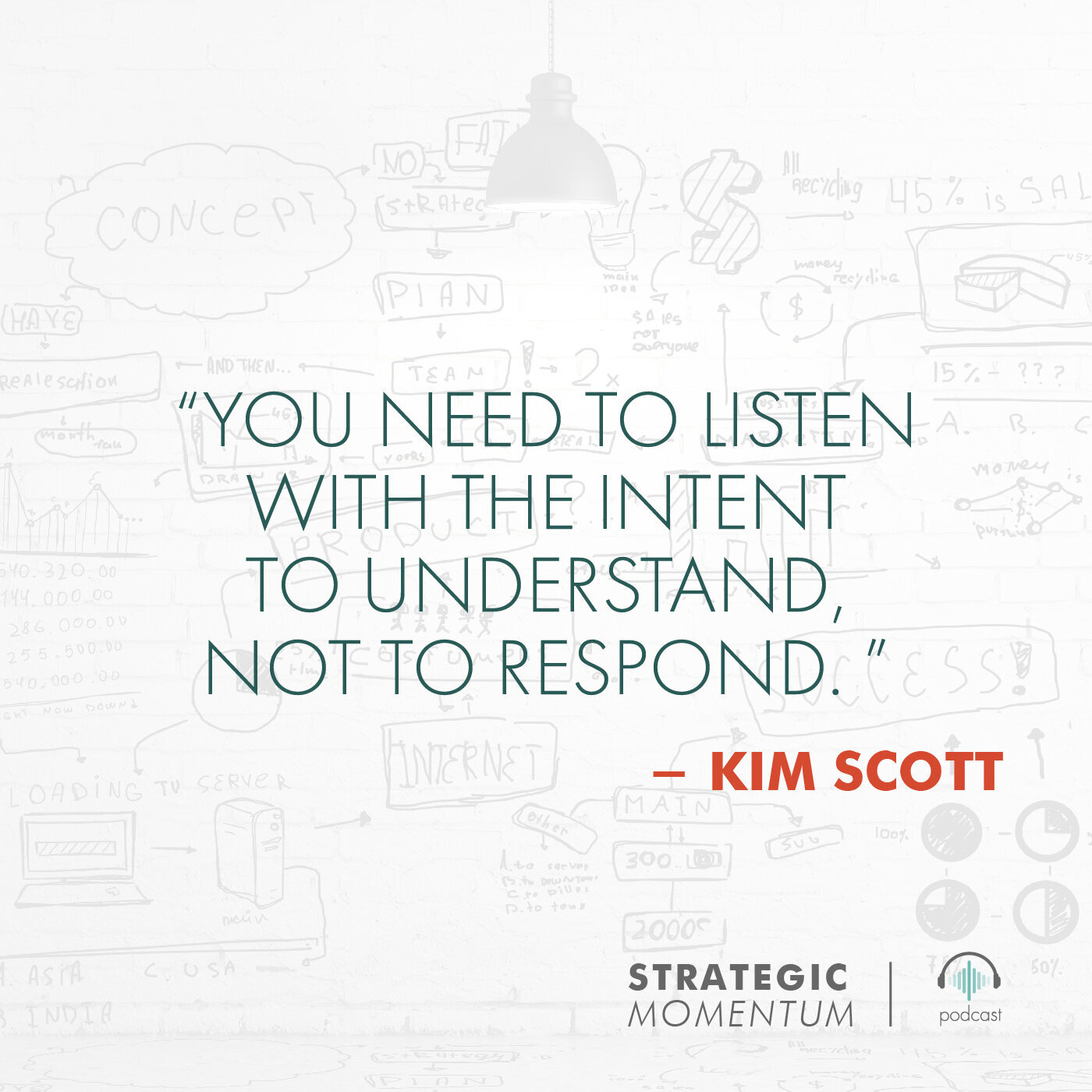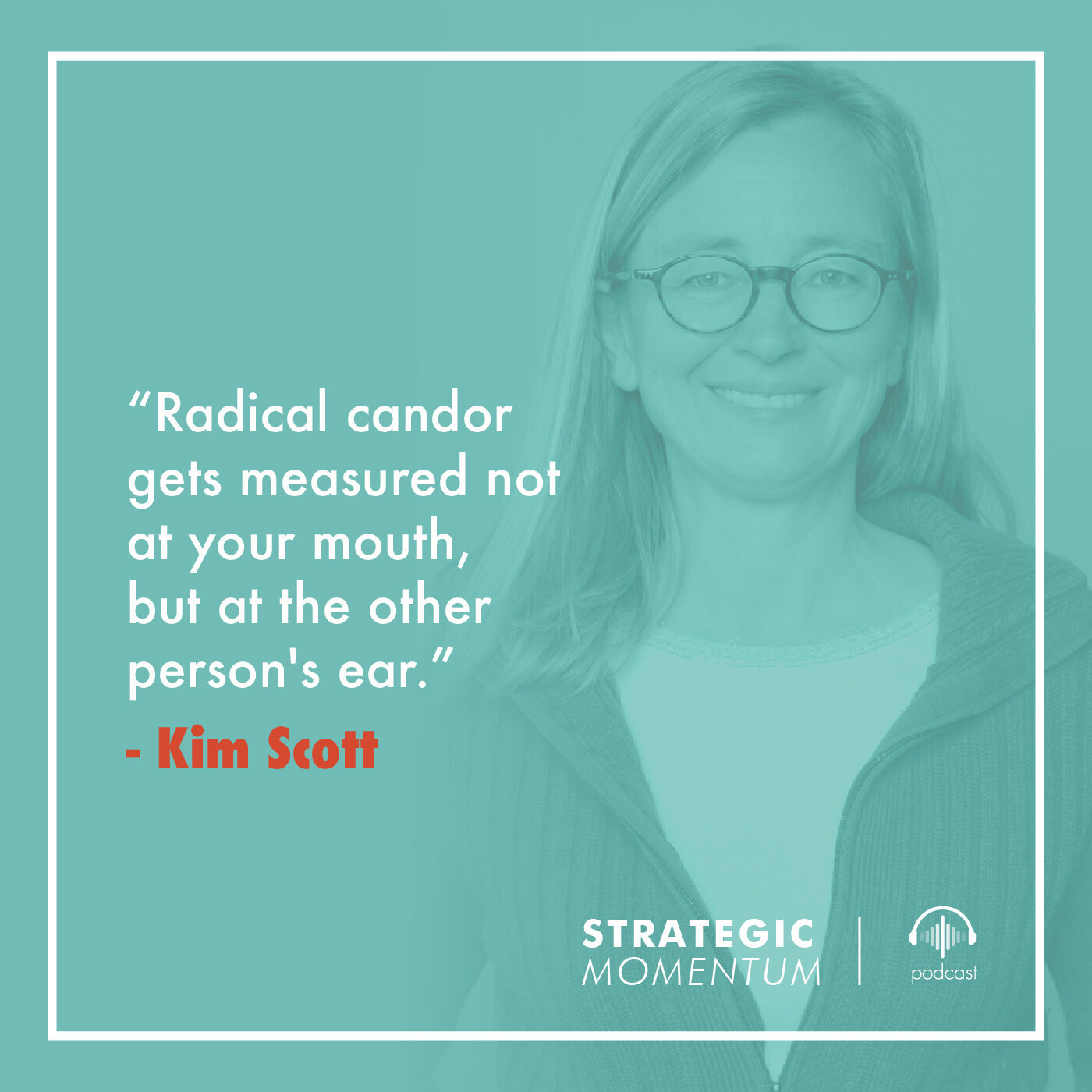Ep. 73 - How to be a Kick-Ass Boss: Being Radically Candid to Propel You and Your Team Forward with Kim Scott
Find Us Wherever You Listen To Podcasts
We’ve all had our share of bad bosses and we’re familiar with the negative impact they have on our ability to grow and thrive. Kim Scott, co-founder of Candor, Inc. and author of the NYT & WSJ bestseller Radical Candor: Be a Kick-Ass Boss without Losing your Humanity has made it her company’s mission to rid the world of bad bosses by helping organizations create BS-free zones at workplaces around the world.
Her breadth of experiences have given her an in-depth perspective on the conditions that people need to do their best work. She was a startup founder and CEO, led AdSense, YouTube, and Doubleclick Online Sales and Operations at Google and then joined Apple to develop and teach a leadership seminar. Further, Kim’s been a CEO coach at Dropbox, Qualtrics, Twitter, and several other tech companies.
And what she’s learned is that it takes being radically candid as a manager - caring personally while challenging directly to create the right momentum.
In this episode, Kim shares:
Where some of the bad boss behavior emanates from
The challenges that many leaders face when it comes to knowing how to guide their teams effectively
The concepts, applications and benefits behind the Radical Candor framework
How to deliver praise and criticism in a way that is helpful
Being Cared for Personally and Challenged Directly to Create Career and Team Momentum
Kim found that one of the most difficult aspects of becoming a leader was challenging people directly. And Radical Candor was really a solution to something she struggled with early on in her career.
“I was taught since I grew up, if you don't have anything nice to say, don't say anything at all. And all of a sudden, it was my job to say it, and that was really hard. But I didn't want to lose the kindness that came along with that sortation, not to say anything mean.”
At the software startup she founded, an experience she had with her employees also really got her thinking about leadership. One day, 10 people sent her the same article from The New York Times about how people would rather have a boss who is a “complete asshole, but really competent than a boss who is really nice, but really incompetent.” What she didn’t know was whether her employees thought of her as a jerk or incompetent. Regardless - those extremes didn't seem like they should be the only two options to being a good boss.
It was her experience at Google under Sheryl Sandberg that led her to realizing how to motivate and cultivate her/a team. While Kim’s presentation to the founders and CEO of Google about how the AdSense business was doing went incredibly well, Sheryl still had some constructive feedback that Kim didn’t pick up on the queues immediately.
“Sheryl began the conversation by telling me about the things that had gone well in the meeting, not in the feedback sandwich sense of the word, but really seeming to mean it. And eventually, of course, I was getting impatient because all I wanted to hear about was what I had done to screw it up. And eventually, she said to me, “You said a lot of ums in there. Were you aware of it?” And I sort of made this brush-off gesture with my hand because if that was all I had done wrong, who really cared, I had a tiger by the tail. And Sheryl said, “You know, I know this great speech coach. I'm sure that Google would pay for it. Would you like an introduction?” And once again, I made this brush-off gesture with my hand. I said, “No, I'm busy. Didn't you hear about all those new customers? I don't have time for a speech coach.”
I'm not taking the hint. And then, she stopped, she looked right at me and she said, “I can see when you do that thing with your hand, I'm going to have to be a lot more direct with you. When you say um every third word, it makes you sound stupid.” Now, she's got my full attention.
It was Sheryl’s direct and clear communication that triggered Kim to see a speech coach and learn for herself that she truly needed the improvement despite her past successes of raising millions of dollars for past start-ups and her own perception that she was good at speaking because of her past success in raising money.
All of this got her thinking as to why no one in the past gave her this feedback and what was it that made it seemingly easy for Sheryl to deliver that criticism? What she realized is that Sheryl truly cared about her as a person but wasn't going to let her concern about Kim’s feelings get in the way of telling her something she needed to know in the long run.
So it was identifying the ability to care personally and challenge directly that went on to launch Kim’s passion for bringing Radical Candor into the workplace.
As Kim says, when you can offer Radical Candor ”you build the best relationships of your career and you help everyone do the best work of their lives...When you can offer the feedback, it helps you build the team. A great team, it gives better results. When you get great results, it becomes easier to praise and criticize one another.”
Her goal is to help you develop as a leader and to empower you and your team to do the best work of your lives.
The Framework and What Radical Candor Is and Isn’t
So think of Radical Candor as a new management philosophy - an approach to build these radically candid relationships. Because the goal is to help you fulfill your responsibility as a boss - to guide your team to achieve results.
And guiding your team requires delivering as well as soliciting feedback, which has to be done on a frequent and even on the spot basis to help you build the right culture.
There are 2 dimensions of good guidance - caring personally vs. not, and challenging directly vs. silence. These dimensions when combined gives us four quadrants.
Being Radically Candid is the upper right hand quadrant. Here you are caring personally and challenging directly.
Obnoxious Aggression is when you criticize someone without taking any time to show you care. Now ironically, Kim says this is the 2nd best thing to do if you aren’t Radically Candid, only because people know what you think and where they stand. Kim also calls this front-stabbing.
Manipulative Insincerity is when you don’t care enough about a person to challenge directly. Think of it as passive aggressive behavior)
Lastly there is Ruinous Empathy and this is the behavior that is actually responsible for the vast amount of management mistakes that Kim’s seen in her career. Most people want to avoid creating that uncomfortable tension at work and don’t want to be seen as the bad guy.
The myth however, is that by showing you care but NOT challenging directly, you build a relationship with your employees and then move over to Radical Candor.
We have to remember that this Radical Candor framework reflects behaviors and not personality types. Everyone falls into one of these quadrants at some point in their career so it’s important to not label someone as such. Think of it like a compass to guide conversations to a better place.
Soliciting and Delivering Feedback that’s Helpful.
The ability for managers to deliver feedback in a way that is both kind and clear, specific and sincere is not easy to do. Showing that vulnerability and being able to communicate what you really think when it’s not positive isn’t what we are taught.
So to work towards building radically candid relationships with your direct reports, it starts by soliciting criticism first and subsequently rewarding the candor. There is a right time to ask for that feedback as well as a way to reward what they tell you vs. getting defensive.
And when it’s your turn to deliver feedback, you need to find the right balance of praise and criticism that’s done immediately vs. saving it up for a one-on-one conversation. The purpose of praise is to show people what to do more of and the purpose of criticism is to tell people what to do less of.
As a leader, remember that relationships not power drive you forward. There is this virtuous cycle between your responsibilities and your relationships. And as Kim states in her book “You strengthen your relationships by learning the best ways to get, give and encourage guidance, by putting the right people in the right roles on your team and achieving results collectively.”
Make it a habit of soliciting and giving frequent, on the spot guidance because you have to develop a culture of trust to create those healthy relationships. And the way you go about doing it won’t be the same for each person. Everyone will be different so you can’t have a cookie cutter approach. Don’t forget that radical candor gets measured not at your mouth, but at the other person's ear.
In the end, by learning to be Radically Candid, you can be that kick-ass boss without losing your humanity.
Career Advice
Whatever you're doing, work to earn the money that you need to survive, but also put who you are as a person into your work, then you will take a step in the direction of your dreams.
Don't give up on those dreams because you really can fulfill them, but don't get discouraged when the thing you're doing today doesn't reflect your dreams.
Key Takeaways
Radical Candor isn’t a personality type like a Myers Briggs test and it’s not an excuse to behave like a jerk.
It comes down to the manager’s awareness of how they are engaging honestly with their employee, a team member or their boss.
To be Radically Candid, you need to practice it up, down and sideways. And it involves getting that feedback first and making sure that you're listening versus dishing that out.
There's not an objective measure. It depends on how the other person is responding. You've got to experiment with different things and adjust on the care personally dimension or move over more on the challenge directly dimension when you need to.
Think of Radical Candor as brushing and flossing for your relationships. It's not a root canal.
Relationships are core to your job as a boss - they determine whether you can fulfill your responsibilities as a manager, which are to:
Create a culture of guidance (praise and criticism) that will keep everyone moving in the right direction
Understand what motivates each person on your team well enough to avoid burnout, boredom or keep the team cohesive
Drive results collaboratively
Remember that Radical Candor gets measured not at your mouth, but at the other person's ear.
You need to be able to adjust how you’re talking to suit the needs of the person you are talking to. You’ll have to experiment to some degree with each and every person based on their receptivity, emotions and feedback .
Everyone is different so it’s important to be mindful of that and especially when you have a global team where you need to take into account their culture.
Eliminate the phrase, ‘Don't take it personally’ from your vocabulary because emotions do matter.
There’s an order of operations to being Radically Candid.
Step 1- Solicit feedback first and make sure you are listening vs. dishing out criticism.
One of the best times to solicit criticism is at the end of a one-on-one meeting. So, if you're the boss and you have a one-on-one meeting with an employee, you want the employee to own the meeting and to own the agenda.
Mostly, you're going to talk about what they want to talk about, but save five minutes at the end to solicit feedback vs. offering it.
Step2 - Be silent and embrace the discomfort.
You have to make people feel uncomfortable for them to tell you the truth contrary to what you might think.
Stay silent for about six seconds (which most people can’t endure six seconds of silence) and the other person will probably tell you something. “It may not be like the most profound feedback, but they'll tell you something. So that's good.”
It is vital that you respond openly and manage your instincts to be defensive because you will likely feel so. “You need to listen with the intent to understand, not to respond.”
Step 3 - Reward the candor. It's not enough not to get defensive, you actually have to reward the candor.
If you agree with the feedback then fix the problem as well as ask the person if you went far enough in addressing it.
If you disagree with the feedback, have a conversation with a person about why you disagree but first take a moment to identify the 5% or 10% that you can agree with.
It demonstrates that you're open to the feedback, that you're not defensive.
Very often, a good explanation of why you disagree is a nice reward. “Disagreements can actually strengthen relationships if they're conducted with respect. Ignoring what someone tells you never improved any relationship ever.”
By doing these things you are reiterating what they are saying and showing them you care.
Another moment when it's very effective to solicit feedback is to go talk to someone when they are angry with you. While this is counterintuitive, they're more likely to tell you what they really think.
Remember don't try to make them mad, but if they are mad, it's a good moment to solicit data.
Come up with your go-to-question to solicit feedback as well as when you are going to deliver it.
Example - “What could I do or stop doing that would make it easier to work with me?”
Make sure to follow through on that question as nobody wants to give you feedback, especially if you're their boss. So, you've got to embrace the discomfort.
In terms of when the best time is to give feedback, it shouldn’t be saved up for a one-on-one time but rather it is best done as impromptu two-minute conversations.
When going into these two-minute conversations, it’s so important to be humble as you could be wrong about your assessment of what's good or bad.
Don't go into it as though you're the arbiter as one of the fastest ways to give really bad praise is to sound patronizing.
You need to balance praise and criticism when delivering feedback and sometimes you need to give more praise than criticism even though everyone wants to know what’s wrong first.
Your job as a leader is really to paint a picture of what's possible. And praise is a much more important tool than criticism for painting a picture of what's possible.
Nobody buys the feedback sandwich (praise, criticism, praise) as they see through it immediately.
“You can't paint by numbers when you're building a relationship. So, you just want to make sure that you're conscious of focusing on the good stuff.“
It's critically important that your praise be specific and sincere and that your criticism be kind and clear, and that there’d be more praise than criticism.
State your intention to be helpful with both praise and criticism.
Specific and sincere praise shows the person as well as the team what to do more of.
Helpful (and immediate) criticism tells the person what to improve upon.
The purpose of praise is to show people what to do more of and the purpose of criticism is to tell people what to do less of.
When delivering criticism, don't make it about the person's personality. It's very difficult to change our fundamental personality attributes.
Think about using the framework of situation, behavior, impact to deliver feedback because you want to make sure you are commenting on something the person can change and improve upon.
You don't want to be too abstract. You want to think about, what did the person do? What did their work look like? What was the impact of that worked? And then, help them do more of it if it's praise or do less of it if it's criticism.
Remember there is a hierarchy with respect to the communication medium you use when giving feedback or delivering praise and criticism.
85% of communication is nonverbal so that’s why in-person communication is so important.
Video is 2nd best to in-person because you are doing it synchronously - it offers the ability to see a people's expression and somewhat their body language a little bit.
Phone would be the 3rd best option because it is also synchronous as it gives the person the opportunity to respond and you can hear their tone of voice, sense how it's going, and be able to adjust what you're saying.
Do not give feedback over text or email
Criticism should be done in private while praise can be done in public.
Think about it in terms of synchronous relationship building and asynchronous efficiency.
If it's just information, send out the email. If you really need to understand how the person is responding to the information, then set up a video call.
Ideally offer both praise and criticism in person especially criticism. BUT in this virtual world we are now in, the second best option is to do it via video and in private.
While it’s not as good as being in person, you get some fidelity.
If you can't do it over video, do it over phone.
Be conscious of what you can do over video and what you don't need to do over video especially during this time when we're not in the same place at the same time.
If you're doing good feedback maintenance, these are conversations that you build in between things. It's really fast and it's free to do, but it does require enormous emotional discipline because it's our instinct not to do this.









